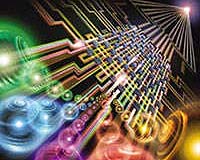 |
San Francisco (AFP) Aug 17, 2009 IBM on Monday said it was looking to DNA "origami" for a powerful new generation of ultra-tiny microchips. The US computer giant collaborated with California Institute of Technology researchers to develop a way to design microchips that mimic how chains of DNA molecules fold, allowing for processors far smaller and denser than any seen today. "This is a way to assemble an electronics device of the future," said Bill Hinsberg, manager of the lithography group at IBM's Almaden Research Center in California. "It offers a potential way to construct nano-scale devices. The industry has always gone in the direction of making things smaller, because that opens the realm of possibilities." A tenet of the chip industry is Moore's Law, a history-backed belief that the number of transistors that can be placed on a computer circuit doubles every two years, enabling smaller but increasingly powerful computing devices. Lithography is a common method of making computer chips that have shrunk to contain technology measuring a mere 22 nanometers. The "DNA origami" method can allow for chip features as slight as 6 nanometers, according to IBM. "At some point, it gets more difficult to get smaller," Barnett said. "We've pursued DNA origami as a way to assemble an electronic device of the future." DNA origami chips would have vastly increased data storage capacity and lead to power smaller, faster, smarter devices, IBM said. "It took a couple of years, but once you figure out how to do it, it's easy," said lead IBM researcher Greg Wallraff. The DNA method is to assemble chips "from the molecule up" in a way that costs less than today's manufacturing methods, the technology titan said. IBM expects it will take about a decade before DNA origami technology reaches the marketplace. "You'd have to develop whole new ways of fabricating the chips," Wallraff said. "You have to really change the way you do things." Share This Article With Planet Earth
Related Links Computer Chip Architecture, Technology and Manufacture Nano Technology News From SpaceMart.com
 EPEAT green electronics registry goes international
EPEAT green electronics registry goes internationalSan Francisco (AFP) Aug 10, 2009 The Green Electronics Council on Monday went international with a registry that shows how computers and monitors measure up when it comes to being Earth-friendly. Electronic Product Environmental Assessment Tool (EPEAT) registry that gives green ratings to computer desktops, laptops, and monitors has been localized for 40 countries. "It is an exciting development," said EPEAT executive ... read more |
|
| The content herein, unless otherwise known to be public domain, are Copyright 1995-2009 - SpaceDaily. AFP and UPI Wire Stories are copyright Agence France-Presse and United Press International. ESA Portal Reports are copyright European Space Agency. All NASA sourced material is public domain. Additional copyrights may apply in whole or part to other bona fide parties. Advertising does not imply endorsement,agreement or approval of any opinions, statements or information provided by SpaceDaily on any Web page published or hosted by SpaceDaily. Privacy Statement |